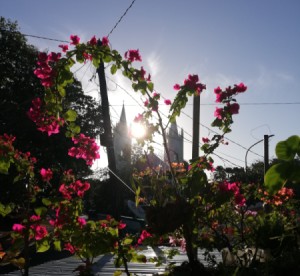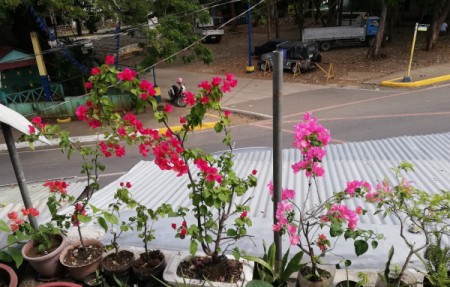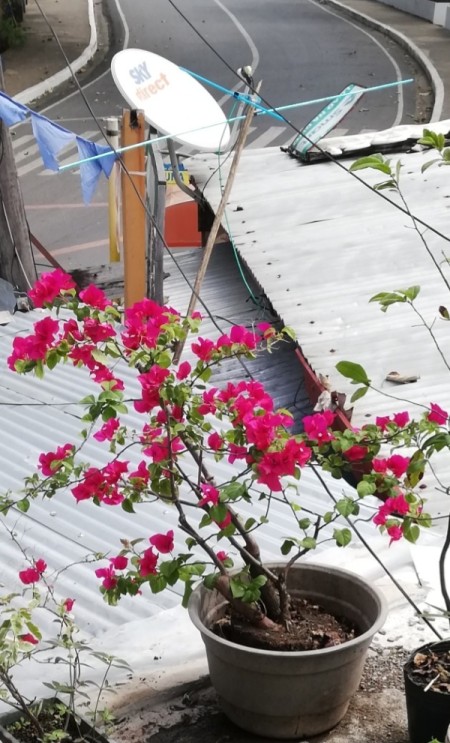 I'm Rosalie from Philippines, I love to share my tips on how to make your bougainvilleas bloom all year round, non-stop blooming. I've been planting bougainvilleas for almost 5 years now and I'm happy to say that I enjoyed watching them blooming every day.
I'm Rosalie from Philippines, I love to share my tips on how to make your bougainvilleas bloom all year round, non-stop blooming. I've been planting bougainvilleas for almost 5 years now and I'm happy to say that I enjoyed watching them blooming every day.
Here are my tips, just save your urine in a pail any time of the day then just add some water to it and you can use this mixture to water your bougainvillea, morning and afternoon, you can do this thrice a week and expect that anytime soon, your plant will bloom.


Here are the questions asked by community members. Read on to see the answers provided by the ThriftyFun community.
Hardiness Zone: 6b
Thank you,
Christy from Colorado
A: Christy,
It can be challenging to get Bougainvillea to flower under ordinary indoor conditions, so if possible move them to a sunny location outdoors for the summer. Like other flowering houseplants, Bougainvilleas need more light than non-flowering houseplants. Daylight triggers blooming. They will usually bloom when the number of available daylight hours equals the number of hours of darkness. During this time they need a minimum of 5 hours of direct sunlight each day. In the spring and summer, keep soil moist and temperatures warm-the warmer the better.
Ellen
You need to give it LOTS and LOTS of water. And hang outside in the morning sun.
Bougainvillea is an outdoor plant. I have them all over here, they thrive on neglect and flower profusely.
I live in country New South Wales in Australia....I too have a beautiful bougainvillea growing in my front garden in FULL sun most of the day, shaded by the verandah in the late afternoon (it's the middle of summer here now)....it is definately an OUTDOOR plant and needs lots of sunshine to produce flowers.....in the winter, it loses most of it's leaves so looks like a very woody plant with thorns.......be careful, the thorns really hurt! Try putting your bougainvillea outside in the sun but keep away from FROSTS, don't forget to prune it back a little, this encourages more blooms in the Spring......Good luck, Kay from OZ
I keep a small Bougainvillea inside. It is really a form of vine and thus is rather spindly. It needs to live in a South window where it gets a lot of sun and be cut back regularly since it flowers only on new growth.
I keep a bougainvillea inside. It is a vining plant ant thus really is naturally rather spindly. The flowers are tiny and it is the colorful bracts that surround them that most people consider the blooms. It needs to live in a south facing window with a lot of sun. It also needs to be cut back fairly often to keep it under control and also because it only flowers on new growth. I water mine weekly but I have learned that to bring it into flower, once the current bracts dry up and fall off, I skip a week of watering and let it get dry. Then I water it rather sparingly until the new bracts form.
It may be an area specific thing, but... My experience is the same as Linda's. I'm in San Diego (USDA Zone 10+, Sunset Zone 23)-- leave them alone except for pruning, and they do fine...
One of my bougainvillea plants in the hanging basket has severely wilted due to lack of water and high temps of 100 here while I was sick and didn't water it. It's full of blooms, but completely wilted. I watered it thoroughly and it's not resurrected yet. I have placed it in shade near tree for today. The other plant beside it is fine. Any ideas on how to help this one?
By Angela
Water, water, water. Find a larger bucket / or pan, add about 1 tablespoon of Epsom Salt to the pan, fill with water, mix well until dissolved. Sit(still in the original pot/basket) your plant in the water overnight, let it soak. Good luck. Hope this helps.
Try soaking the entire container in water. My husband taught me this after working for a nursery. Put the entire container in water until the bubbles stop. That will rehydrate the soil.
I need help on planting and growing. I live in zone 8.
Thank you.
If you live in zone 8, it should be fine to plant your bougainvilleas in the ground. However, if you live in a zone lower than 8, it is best to plant them in pots. Here is how to take care of your bougainvilleas once they are planted.
Step 1
Choose a nice sunny spot for your bougainvilleas. They need at least 6 hours of sun a day to grow and produce flowers. Don't plant them in a high wind area. Furthermore, protect them during freezing temperatures during the winter months, this will kill your plants.
Step 2
When choosing a location for your plants take into consideration that the plant is notorious for dropping their leaves and flowers. So find a place that the dead leaves and flowers won't make too much of a mess in the rest of your garden.
Step 3
After the blooming cycle, you will need to lightly prune the plant. This helps the plant grow faster and bloom again.
Step 4
You will need to fertilize your plants every six weeks or after the blooming cycle. I would suggest using an Osmocote fertilizer that is 18-6-12.
Step 5
The plant should be watered so the soil is moist. Don't over water the plant and keep the soil soggy. Wait until the soil dries out before watering the plant again.
I would like to plant bougainvilleas as a hedge and keep them trimmed. Will they require support to go to 6 feet in height? Are the thorns a problem for lawn tractor tires?
By Dave
You do not state where you live so it is important to know that Bouganvilla is a tropical plant best gown in in hot and somewhat dry areas. It can be pruned to appear as a shrub but it will be difficult to make it into a hedge as the plant tends to produce vines that can travel far and wide.
My plant is outdoors in a very sunny spot. It likes to be watered every day because of the heat. I live in Colorado and it has been over 90 degrees every day. If I forget to water the plant one day the leaves and flowers begin to droop.
I am now noticing that the leaves are being eaten and there are large light brown spots on the leaves. There are some very tiny black dots on the back of the leaves and it appears that the light brown spots are areas where something is eating the underside of the leaf. I have looked for insects, perhaps caterpillars, but found no evidence. The areas where it is evident that something is eating the leaves, there are holes in the leaves. What can I do?
By Julie G